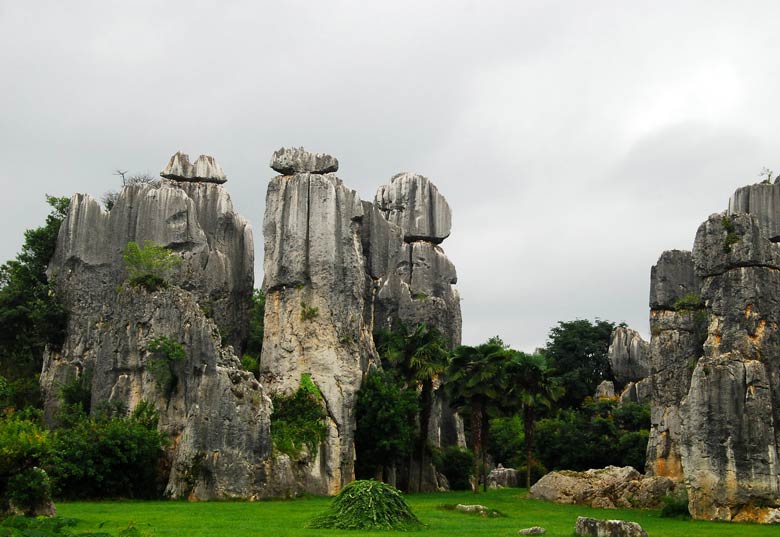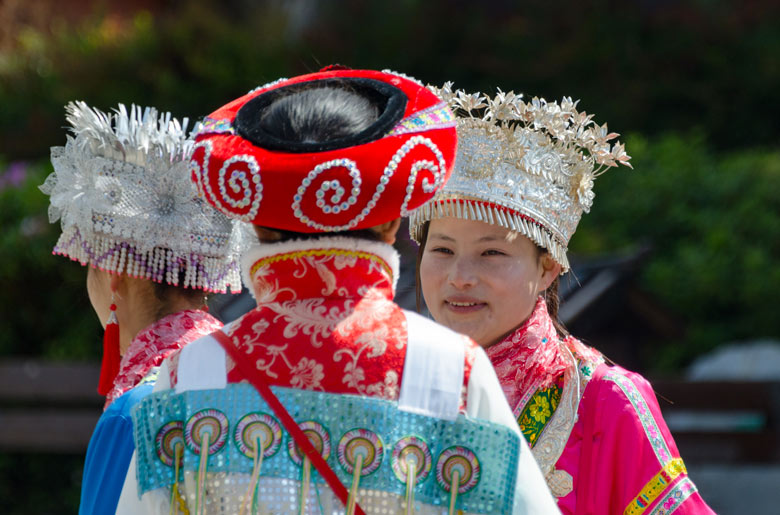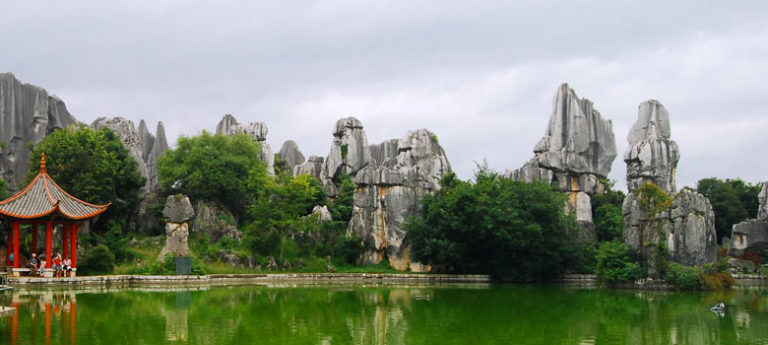Kunming, China: Shilin Stone Forest
© KarmaWeather by Konbi - All rights reserved
Cover picture by Shizhao (source, license) Changes: framing
Geography, facts, legends and travel guide about the Stone Forest, one of China's most impressive landmarks
Stone Forest
Geography (part 1)
The Shilin Stone Forest (石林) is a natural landscape of limestone monoliths, located 84 km from Kunming City, the provincial capital of the Yunnan region of the People's Republic of China, inhabited by the Sani people. As a result of its great geological variety, with its many caves (more than 40!), ponds, waterfalls, its lake and its underground river, associated with its unique beauty, the Stone Forest (or "Stone Teeth") is part of the world heritage of UNESCO (continuation below).
Planning a visit to the Stone Forest
To visit the Stone Forest, the easiest way is to fly to Kunming City, then rent a car or take the bus to Shilin. It takes between 1:20 and 1:40 drive to travel the 91 km between Kunming Airport and Shilin. There is also a Kunming-Shilin train.
What is the cost of the entry ticket to the Stone Forest?
The cost of the ticket to visit the Stone Forest varies according to the profiles of the visitors. If you are an adult, you need 140 yuan (about 18 euros) and half the price for children. A 20% discount is scheduled for all Chinese National Holidays, which include of course the Chinese New Year and Spring Festival period. For more complete information on the entry ticket price list, but also on the geology of the place, its activities and its news, you can visit the Stone Forest website, which is managed by the Yunnan Tourist Information Network.
Geography (part 2)
The formation of the Stone Forest as it can be seen today began 277 million years ago, when the Shilin area was raised out of the sea as a result of tectonic movement. The different geological ages that followed caused the area profound upheavals.
The original layers of limestone were gnawed under the action of the tropical climate, before being covered and literally cooked and buried by lava flows in the Late Permian period. Over the next 160 million years, basalt (porous volcanic rock) eventually wears out, eventually revealing Permian limestone peaks. Since then, the Shilin region has been under tectonic pressure which, by elevating part of the area, has resulted in the creation of Old Lunan Lake and with it a succession of geological phenomena that have contributed, between erosion and new deposits, to shape the Stone Forest as it can be discovered today.
Stone Forest Facts
The Sani people
Stone Forest's Ashima is a Chinese cultural landmark
- The story of Ashima was first published in writing in 1813 in a scroll of tales titled "Tales of the Mountains", which recorded the local legends of the Sani people,
- The tale of Ashima, the girl transformed into a rock in the Stone Forest, was the subject of the first color film of the People's Republic of China, "Ashima", in 1964.
The annual Torch Festival
The call to Ashima
The Sani people (撒尼 人) is a branch of the Yi people, one of the ethnic minorities of the People's Republic of China. The Sani people, renowned for their culture, literature and folk art, are made up of 120,000 out of the 8,000,000 who make up the Yi people. The Sani people live in the center of the Yunnan region, between Shilin and the counties of Yiliang and Luxi. Their language is Yi Sani (撒尼 语), whose dialect and writing system is one of the variants of Yi. The Yi language is part of the Tibetan-Cambodian group of the Sino-Tibetan system.
The Ashima tale is a founding myth of the Sani people and is an integral part of their culture and life ethic. On the 24th, 25th and 26th day of the 6th lunar month of each year, on the occasion of the Torch Festival, singing, dancing and fighting performances are organized by the Yi people to perpetuate the memory of Ashima. The Torch Festival is an opportunity for the young people of the region to put on their best costumes and, by recreating the situations of Ashima's tale, to find a soul mate!
When you find yourself in front of the rock of Ashima and call her by her name, the girl with the tragic destiny will answer you, in echo ...

Stone Forest in popular culture and legends
According to the legend, Azhi, the son of the village chief of Shilin falls in love with Ashima, a pretty farmer's daughter whose heart is already taken. Believing that he has precedence over Ashima's fiancé given his status as the leader's son, Azhi kidnaps the girl with the help of henchmen. After learning the event, Ahei, the shepherd already in a relationship with Ashima, delivers his lover and provokes Azhi in a singing duel to seal their argument. The latter accepts but ends up losing the challenge. However, the leader's son implements his revenge soon after, taking advantage of a nap of the young farmer and her lover on the banks of the river to cause a flood by raising the dam. The girl does not escape the floods and drowns, much to the chagrin of Ahei the shepherd, who shouts her name in vain.
An alternative version of Ashima's tale, which probably precedes the current official narrative, gives another reason than jealousy to Azhi's behavior and motives. In this version of the story, Ashima is actually a princess rather than a peasant's daughter. Therefore, in wanting to marry a shepherd, someone well below her rank, she risks an unpardonable misalliance. Azhi believes that it is his duty to stop her by having her kidnapped so that the girl gives up her project. The tale of Princess Ashima is actually the tragic (but classic) account of love trying to overcome in vain the social and family pressure, and not just a story centered on the sickly jealousy of a village chief's son who tries to take advantage of his privileged status to abuse the innocent happiness of two peasant lovers.
According to tradition, Ashima still remains in the form of a rocky mound bearing her name (the most famous of the Stone Forest) and whose form nibbled by erosion vaguely calls to mind a human form. Just as the monoliths of the Stone Forest reveal yellow and ocher flows under their gray mantle, in the Yi Sani language, Ashima (阿诗玛) means "as bright and precious as gold".

Planning a travel to Yunnan Province
Yunnan is a beautiful and historically rich region of southwestern China, with a rich and varied culture. Many places are worth visiting: the provincial capital of Kunming of course, the Shilin Stone Forest which is the subject of this article, but also the cities of Lijiang with its Black Dragon Pool, and the 3 Pagodas of the Chongsheng Temple, to name only the most emblematic places.
China's Chinese zodiac animal sign and compatibility
Find out how compatible you are with the country you plan to visit
|
